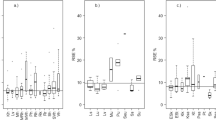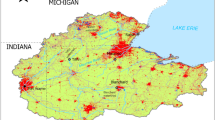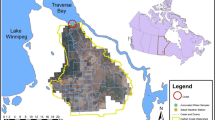Abstract
Patchiness is a typical property of water quality in lakes. However, in conventional water quality monitoring, patchiness is usually too expensive to take into account, due to the high number of required samples. This study examines a feasible methodology developed for estimating the representativeness of discrete chlorophyll a measurements. Four spatially extensive data sets were collected from the Enonselkä basin of Lake Vesijärvi in Southern Finland, using a flow trough system with a fluorometer in a moving boat. Data sets were used to estimate (1) the spatial representativeness of discrete sampling; (2) the effect of varying sample size on the detected mean chlorophyll a concentration and on the observed proportion of variance. Spatial representativeness was assessed using semivariogram analysis. Results indicate that the spatial representativeness of discrete sampling can remain undesirably low. Furthermore, in monitoring programs involving just one or only a few samples, there is a significant risk of obtaining a false estimate for the mean value and variance of chlorophyll a concentration over the whole monitoring area.
Similar content being viewed by others
Explore related subjects
Discover the latest articles and news from researchers in related subjects, suggested using machine learning.References
Anttila, S., Pyhälahti, T., Vepsäläinen, J., & Kallio, K. (2005). Rationalizing water quality monitoring by remote sensing and GIS – results of an end-user survey. Internal report of Finnish Environment institute, 1–19. (In Finnish with English summary)
City of Lahti, Technological and Environmental Services (2006). Vesijärvi II - projekti. Vuosiraportti 2006. City of Lahti, Technological and Environmental Services publications. Retrieved July 28, 2007 from http://www.vesku.net/downloads/Vuosiraportti06.pdf. (in Finnish)
Curran, P. J., & Atkinson, P. M. (1998). Geostatistics and remote sensing. Progress in Physical Geography, 22(1), 61–78.
Dekker, A. G., Vos, R. J., & Peters, S. W. M. (2001). Comparison of remote sensing data, model results and in situ data for total suspended matter (TSM) in southern Frisian lakes. Science of the Total Environment, 268, 197–214.
Erkkilä, A., & Kalliola, R. (2004). Patterns and dynamics of coastal waters in multi-temporal satellite images: support to water quality monitoring in the Archipelago Sea, Finland. Estuarine, Coastal and Shelf Science, 60, 165–177.
Hedger, R. D., Atkinson, P. M., & Malthus, T. J. (2001). Optimizing sampling strategies for estimating mean water quality in lakes using geostatistical techniques with remote sensing. Lake & Reservoirs: Research and management, 6, 279–288.
Heinonen, P., Pietiläinen, O.-P., Airaksinen, O., Haapala, A., Hammar, T., Holopainen, A.-L., et-al. (2004). Monitoring and Assessment of the Ecological Status of Lakes – A pilot procedure developed and tested in the Life Vuoksi project. The Finnish Environment 719
Horppila, J., Peltonen, H., Malinen, T., Luokkanen, E., & Kairesalo, T. (1998). Top-down or bottom-up effects by fish: Issues of concern in biomanipulation of lakes. Restoration Ecology, 6, 20–28.
Jassby, A. D., Cole, B. E., & Cloern, J. E. (1997). The design of sampling transects for characterizing water quality in Estuaries. Estuarine, Coastal and Shelf Science, 45, 285–302.
Johnston, K., Ver Hoef, J. M., Krivoruchko, K., & Lucas, N. (2001). Using the ArcGIS geostatistical analyst. New York: Esri.
Kairesalo, T., & Vakkilainen, K. (2004). Lake Vesijärvi and the City of Lahti (Southern Finland) comprehensive interactions between the lake and the coupled human community. SIL News, 41, 1–5January 2004.
Kallio, K., Koponen, S., & Pulliainen, J. (2003). Feasibility of airborne imaging spectrometer for lake monitoring – a case study of spatial chlorophyll a distribution in two meso-eutrophic lakes. International Journal of Remote Sensing, 24(19), 3771–3790.
Kallio, K., Kutser, T., Hannonen, T., Koponen, S., Pulliainen, J., & Vepsäläinen, J., et al. (2001). Retrieval of water quality from airborne imaging spectrometry of various lake types in different seasons. The Science of The Total Environment, 268(1–3), 59–77.
Keto, J., Tallberg, P., Malin, I., Vääränen, P., & Vakkilainen, K. (2005). The horizon of hope for L. Vesijärvi, southern Finland: 30 years of water quality and phytoplankton studies. Verh. Internat. Verein. Limnol. (29).
Kitsiou, D., Tsirtsis, G., & Karydis, M. (2001). Developing an optimal sampling design, A case study in a coastal marine ecosystem. Environmenal Monitoring and Assessment, 71, 1–12.
Koponen, S., Pulliainen, J., Kallio, K., & Hallikainen, M. (2002). Lake water quality classification with airborne hyperspectral spectrometer and simulated MERIS data. Remote Sensing of Environment, 79, 51–59.
Legendre, P. (1993). Spatial autocorrelatoin: Trouble or new paradigm. Ecology, 74(6), 1659–1673.
Lindell, T., Pierson, D., Premazzi, G., & Zilioli, E. (Eds.) (1999). Manual for monitoring European lakes using remote sensing techniques. EUR18665, Environment and quality of life series. (Luxembourg: Office for Official Publications of the European Communities)
Lindfors, A., Rasmus, K., & Strömbeck, N. (2005). Point or pointless – Quality of ground data. International Journal of Remote Sensing, 26(2), 415–423.
Little, L. S., Edwards, D., & Dwayne, E. P. (1997). Kriking in esturaries: as the crow flies, or as the fish swims. Journal of Experimental Marine Biology and Ecology, 213, 1–11.
Malinen, T., & Peltonen, H. (1996). Optimal sampling and traditional versus model-based data analysis in acoustic fish stock assessment in Lake Vesijärvi. Fisheries Research, 26, 295–308.
Matheron, G. (1965). La Theorie des variables regionalisee et ses applications. Paris: Massons.
Matheron, G. (1971). The theory of regionalized variables and its applications. Le Cahiers du centre de morphologie Mathematique de Fontainebleau 5. Fontainebleau: CMMF.
Östlund, C., Flink, P., Strombeck, N., Pierson, D., & Lindell, T. (2001). Mapping of the water quality of Lake Erken, Sweden, from Imaging Spectrometry and Landsat Thematic Mapper. The Science of the Total Environment, 268, 139–154.
Pannatier, Y. (1996). Variowin. Software for spatial data analysis in 2D. Statistics and computing. Berlin: Springer.
Pulliainen, J., Kallio, K., Eloheimo, K., Koponen, S., Servomaa, H., & Hannonen, T., et al. (2001). A semi-operative approach to lake water quality retrieval from remote sensing data. Science of the Total Environment, 268, 79–93(in Finnish).
Ranta, E., Rita, H., & Kouki, J. (1999). Biometria. Tilastotiedettä ekologeille. Helsinki, Finland: Helsinki University Press (in Finnish).
Sammalkorpi, I., Keto, J., Kairesalo, T., Luokkanen, E., Mäkelä, M., Vääriskoski, J., et-al (1995). Vesijärviprojekti 1987–1994 - Ravintoketjukunnostukset, tutkimukset ja toimenpidekokeilut. Vesi- ja ympäristöhallinnon julkaisuja, 218, sarja A.
Vos, R. J., Hakvoort, J. H. M., Jordans, R. W. J., & Ibelings, B. W. (2003). Multiplatform optical monitoring of eutrophication in temporally and spatially variable lakes. The Science of the Total Environment, 312, 221–243.
Wang, X. J., & Liu, R. M. (2004). Spatial analysis and eutrophication assessment for chlorophyll a in Taihu Lake. Environmental Monitoring and Assessment, 101(1–3), 167–174.
Author information
Authors and Affiliations
Corresponding author
Rights and permissions
About this article
Cite this article
Anttila, S., Kairesalo, T. & Pellikka, P. A feasible method to assess inaccuracy caused by patchiness in water quality monitoring. Environ Monit Assess 142, 11–22 (2008). https://doi.org/10.1007/s10661-007-9904-y
Received:
Accepted:
Published:
Issue Date:
DOI: https://doi.org/10.1007/s10661-007-9904-y




